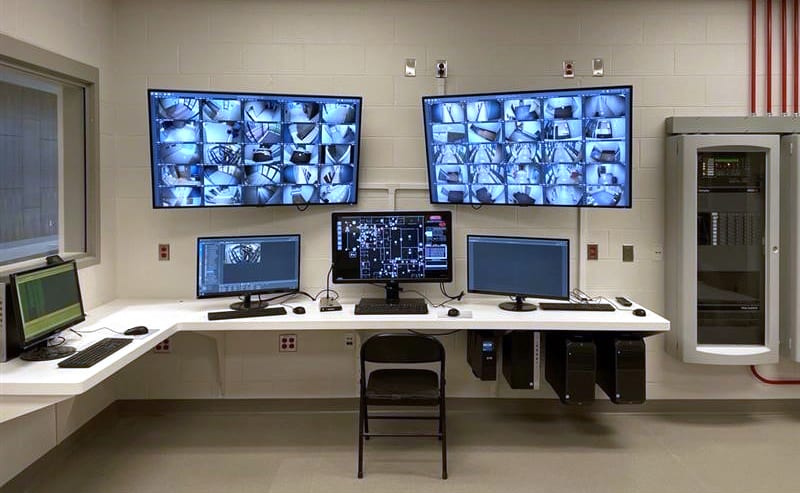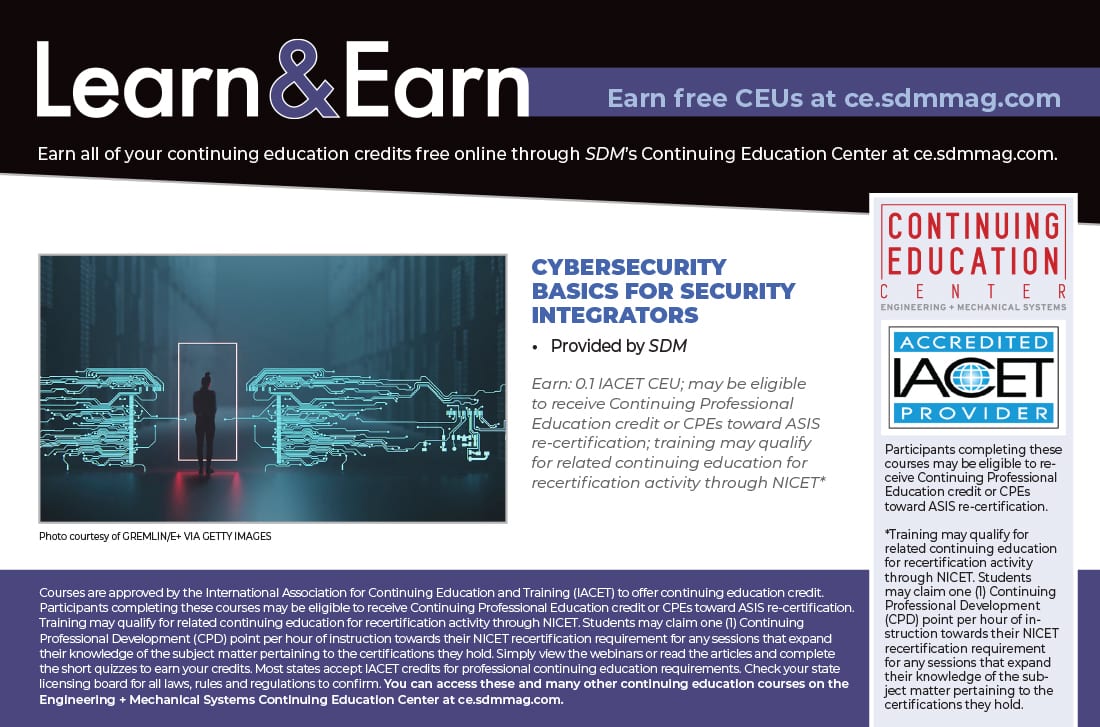// Video Solutions
5 Tips to Choose the Right
VMS for Enterprises

Deciding on the right VMS for a large-scale security application entails envisioning what the client and the system will look like in the future.
Mindful Media/E+ via Getty Images
Industry professionals from the integration and manufacturing communities help explain top considerations when choosing a VMS for your end customer.
By Anna Boudinot, SDM Contributing Writer
Choosing the right video management system (VMS) goes beyond making a customer happy. When it comes to large-scale deployments, security dealers and integrators can improve security, reliability and scalability by choosing the right enterprise-level VMS for their clients.
To help make this pivotal decision easier, here are five factors we gathered from members of the integration community to consider when selecting a VMS for an enterprise customer.
1. Ease of Use
With enterprise-level deployments that have security departments and experienced operators, ease of use doesn’t just mean “easy to operate.” The definition expands to include UIs that help operators save time, do their jobs more efficiently, and easily train new users.
“I look for VMS that’s intuitive,” remarks Gary Chavarria, general manager of security integration, TRL Systems, Rancho Cucamonga, Calif. “It’s easy to go in and search quickly and efficiently; it leads me down a simple path. I like systems where you don’t need more than two clicks to get any place. Once you have to click more than twice, it’s no longer user friendly.”
Lon Bazelais, president, Grid Squared Systems, Astoria, N.Y., adds that ease of use means not only how easy the system is going to be to operate, but how easy it is to maintain as well. "A system across multiple sites can very easily become unruly and hard to manage,” he explains. He recommends choosing a VMS that an end user can easily operate and manage from both a local operator level and a global operational level.
2. Integration
The ability to integrate with other devices is obviously the foundation of a VMS, and integrators should consider third-party programs for integration as well as the typical intrusion detection and access control systems. “A VMS should be able to integrate into third-party analytics platforms including those that allow for facial recognition,” Chavarria comments.
DJ Adamski, senior electrical engineer, Accurate Controls, Ripon, Wis., notes important factors to consider for camera integration. “The VMS should have a basic ability to stream and record all types of cameras, including fixed, 360-degree cameras with full dewarping capabilities within the software, and bring multi-lens cameras into it as well.”
Integration also means keeping future integration (scalability) in mind. Anticipating what an enterprise will need as their company — and, in turn, their security needs — grows is another important factor in choosing a VMS, Bazelais says.
Chavarria recommends software-based VMS for this reason. “I tell my customers you’re never going to outgrow it,” he remarks. “Additionally, staying with a nonproprietary app allows us a lot of flexibility and lets us focus on the needs of the client both today and what we might see five years from now. We look at where are they at today with technology and where are they going.”
A VMS should have a basic ability to stream and record all types of cameras, including fixed, 360-deg. cameras and multi-lens models as well.
moisseyev/iStock / Getty Images Plus via Getty Images

3. Features
Which VMS features are must-haves and which are just bells and whistles? Answering this question should be based on which specific features that the end user requires or will find beneficial, Bazelais explains. “Every VMS does the basics but what separates one platform from another, and what are the costs associated with those features?”
Adamski adds, “Not all economical video management systems can provide every feature that an upscale system can provide. When the [enterprise] owners are looking for a VMS that can do basic functions such as live stream, record, and search on motion, then we can offer huge cost savings over a system that needs perimeter analytics, mobile viewing and advanced search options.”
Aaron Whitaker, owner, Preventia, Columbia, Tenn., agrees. “Camera systems have become about much more than security, so a VMS needs to offer more,” he says. “The actual features or capabilities of the VMS and how our clients will be able to benefit from them makes a big difference. We want to make sure they are competitive with other offerings and solve problems for clients.”
How Your Team Can Better Support Enterprise Clients
Helping enterprise customers successfully manage their VMS deployments begins with preparing your internal team and fostering collaboration among the many stakeholders on the client side.
“We have a very consultative approach with our clients,” Aaron Whitaker of Preventia explains. “We invest heavily in education for our team to help get expectations right on the front end. We involve the VMS provider in the process and include all necessary parties in meetings with the client. Typically, we are dealing with as many as 10-15 people across two to three departments to execute a large-scale deployment, so communication with these people and on our team is critical. By involving the VMS provider early, we can solve problems or make adjustments quickly.”
Gary Chavarria of TRL Systems adds, “I want to make sure we’re using a VMS on which our people have been certified and trained. It’s important to represent systems that have solid training programs that make our people better — especially systems that require IT integration. We work with clients’ IT groups to make sure we’re compliant with everything they need. This gives us a lot of flexibility to make sure we’re deploying the right thing when they need it. We’re residing on their network, so we have to understand how their network operates and speak the same language as their staff.”
//
4. Performance
VMS manufacturers strive to make their VMS reliable because integrators know that a VMS is nothing if it can’t be depended upon. Whitaker states, “Performance, for us, is all about reliability and uptime. We prefer cloud VMS solutions, and it is critical that every time a customer needs to use it, it works.”
Chavarria’s perspective is that “An enterprise solution has to work seamlessly across an entire WAN. A lot of that is predicated on the strength of the network, but on the video management platform side it has to have the horsepower to be able to take in a tremendous amount of information and utilize one enterprise master server, as well as compute and send the information out to other regions.”
He also notes that a VMS needs to have the ability to be redundant and, if necessary, use failover technology as well.
Adamski concurs. “Because many of our systems have multiple servers in multiple equipment rooms, as a company we like to make sure each system has some type of failover so that when the system has issues, it can recover and maintain its basic ability to live stream and record video.”
What Makes a VMS Reliable?
The cornerstone of VMS performance is reliability, but what does that mean? We spoke with VMS providers to hear their thoughts on what makes a VMS dependable.
Sanjay Challa, chief product officer, Salient Systems, Austin, Texas
“For most of the market, VMS reliability is simply the ability to receive, record and view video data without unplanned interruption. Users want peace of mind that their video is being recorded, regardless of how or where, meaning they need a recording system that does not crash, hang or go offline, resulting in video not being recorded. To ensure all of this, their VMS needs real-time recording server health monitoring and notifications; the ability to detect and alert on gaps in recording; recording server failover; and the option to run the VMS in a virtual environment.”
Dean Drako, founder and CEO, Eagle Eye Networks, Austin, Texas
“Reliability is one of the main reasons integrators increasingly are opting for a cloud VMS. For optimal reliability, a traditional VMS needs to have the newest features, bug fix, and cybersecurity updates installed as soon as available. While integrators want reliability, they do not want to have to roll a truck every time a new update is released or hardware fails. Cloud VMS is equipped with continuous delivery of services. This means that all new updates are automatically delivered via the cloud to a customer. Cloud VMS users can also easily adjust retention time of cameras immediately without the deployment of additional storage hardware, further increasing reliability.”
Michael Brewer, regional marketing manager – video systems, North America, Bosch Security and Safety Systems, Fairport, N.Y.
“VMS resilience is tied to the architecture that VMS servers are built upon. A VMS management server should be separate from the video recording manager, which directs the cameras to their recording destinations. The storage should also be separate by extension, and all should be independent from the workstation where the operator works. These services can all be installed on a single machine, but failover protection and resilience comes from running them separately. This means that in the event of a system failure, the other components can continue to operate and the solution remains available to operators.”
Eric Moe, director of sales, North America, Milestone, Lake Oswego, Ore.
“VMS software remains dependable by providing a process for software developers to write applications that integrate with many versions of VMS through a software development kit [SDK]. Applications written to the SDK should be forward and backward compatible and provide the best user experience no matter what software version the customer is running. In addition, validating partner integrations through a testing further guarantees reliability and a strong user experience.”
Laurent Villeneuve, senior product marketing manager, Genetec, Montreal
“A VMS should come with multiple data protection layers by default and native disaster recovery capabilities. The video streaming and archiving workloads empowering the system should be able to run indefinitely and without interruption. Customers should experience uninterrupted access to live and recorded video at all times, even if they lose connectivity with the server. Built-in archiver and directory failover should work in conjunction with redundancy features to protect recordings from any network failure and physical damage. A VMS should also provide end-to-end protection of video, data and communications with at-rest and in-transit encryption, managed device certificates, and authenticated connectivity and video anonymization, helping customers fully protect private data and everyone’s privacy.”
//
5. Total Cost of Ownership
When determining total cost of ownership to an enterprise customer seeking a VMS, integrators should make calculations beyond the price tag.
Whitaker explains, “It’s not about the lowest price, it’s about the best value for the client. Flexibility in pricing is very beneficial to make sure you can adapt to different clients as well. We’ve actually passed on a lot of VMS solutions that have been offered to us at a lower price point because the features and overall value didn’t match.”
Adamski contributes additional elements that go into this equation. “How much is the upfront pricing versus the SMA [separately managed account] fee or subscription fees?” he asks. “A lot of facilities we install in remember the days of DVRs where you purchase the equipment and only replace it once the unit has failed. Numerous facilities are unprepared for ongoing maintenance of hardware such as switches, hard drives and servers and have to [later] budget for replacements. Several video management systems require a service maintenance agreement to receive software upgrades in addition to support for the vendor/installer, while other video management systems do not require this to receive the same support.”
Among cyber-hardening feature sets, a VMS should provide end-to-end protection of video, data and communications with at-rest and in-transit encryption.
IMAGE COURTESY OF ACCURATE CONTROLS

Selecting the right VMS for a large-scale security application entails envisioning what the client and the system will look like in the future and which attributes the client will find most valuable in the present. A thoughtful analysis that determines dependability of system performance, future-proof and integration capabilities, and long-term cost breakdown will set integrators up for success with enterprise clients. SDM

